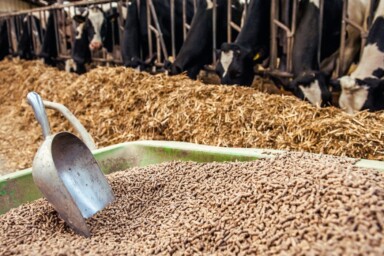Livestock have had a tough time lately. Criticised for contributing to climate change and other environmental problems, they are often written out of discussions around sustainable food. But, despite their bad reputation for environmental damage, when managed holistically they play a critical role in conservation and increasing biodiversity – and may even play a part in reducing atmospheric carbon. As such, livestock should be seen as a cornerstone of sustainable farming systems, rather than a hindrance to them. A recent ‘Open-Gate’ day at Croome Court, organised by RegenAg UK and sponsored by Holistic Management International, showed just how beneficial the holistic management of livestock can be.
Originally developed by Allan Savory in order to reverse desertification in Sub-Saharan Africa, Holistic Management has grown into a global phenomenon. Whilst the approach originated in brittle environments, experienced practitioners have also been using the principles which are appropriate to more temperate non-brittle contexts to improve productivity and the financial bottom line at the same time as rebuilding soils and restoring ecosystem processes. Placing emphasis on the whole system, including wider ecosystems, this approach works with natural processes rather than seeking to control them.
Savory has shown that the reduction of livestock numbers can actually make the problem of soil degradation worse; it isn’t the total number of stock, but the time the stock spend on any given area which is key – and it is only with a sustainable holistic management method, inclusive of livestock, that we can manage land optimally for both humanity and the environment as a whole.
This approach to agriculture is embodied here in Britain by RegenAg UK (RAUK), which was set up to facilitate knowledge sharing and provide training to farmers, members of the public and organisations. Courses are always top quality and you can read a review by SFT’s Hannah Steenbergen of last year’s Regenerative Agriculture Startup Day at Landews Meadow Farm here.
Croome Court provided the perfect venue to discuss holistic farming. A mid 18th century mansion surrounded by extensive landscape in South Worcestershire, it was the first large-scale commission of renowned landscape designer and architect, Lancelot ‘Capability’ Brown.
By the late 20th Century the parkland had been converted to conventional arable farming and when the National Trust took over in the late 90s their goal was to recreate Capability Brown’s original landscape. They began by re-introducing traditional grazing systems to the land. Land manager Rob Havard suggested adopting a holistic planned grazing approach (HPG) with his 40 head of cattle, believing holistic grazing was the best method for creating a natural-looking landscape, rich with flowers and wildlife. HPG is a tool those practising Holistic Management use if they are graziers.
Holistic planned grazing mimics the natural movement and behaviour of wild herbivores. In the wild, grazing animals move in groups, intensively grazing one patch then moving on to another. They move around in ‘mobs’ and so the distinction between HPG and basic mob grazing is sometimes missed. Holistic Planned Grazing takes mob grazing further by incorporating multiple aims, planning carefully and monitoring results to ensure that those mobs interact with the sward in a way which enhances soil and sward health, and thereby the environment and animal health and productivity as well.
Giving the pasture a chance to recover fully before being re-grazed, has many benefits – to the soil, wildlife, and in terms of output. This form of grazing also ensures that manure is spread more evenly and the trampling of some of the longer grasses into the soil, incorporates more organic matter.
Better ground cover with longer grass and a more extensive root mat means that water infiltrates much better too, reducing flooding, mitigating drought, and restoring depleted aquifers.
Farmers around the UK are pioneering this approach, moving animals to fresh land sometimes as frequently as twice a day and using electric fencing to control the size of the areas being grazed to ensure the animals are well fed but also have the desired impact on the land.
At Croome we were treated to a tour of the grounds, which looked stunning despite the grey, rainy day. The impact of Rob’s management on the landscape was obvious, with flourishing wild flowers, a multitude of birds, and the occasional butterfly braving the rain. He assured us that on a sunny day the pasture is a mass of butterflies and pollinating insects.
To many this is perhaps the most obvious impact of Holistic Management; with overuse of fertiliser and pesticides, there has been a tremendous loss of plant diversity in recent years and Rob is clearly doing his part in rectifying that. As he said, “If we can’t do better than roadside verges then we must be doing something wrong.” At Croome, there are now two different species of rare orchids and a host of other rare plants.
One of the most striking moments, highlighting the contrast between holistic and conventional management, was when we walked down to the river running through the valley dividing Croome’s land from a farm on the other side. The river bank on the Croome Court side was abundant with grasses and trees holding the soil together. On the other side, the bank was bare and eroded and the grass short and dotted with weeds.
But it wasn’t all just a walk in the park. We also learnt practical skills, such as how to measure sward and calculate how long livestock could graze an area.
At Croome, landscape is definitely the first priority, and the tour proved, above all else, that livestock are an essential component of this conservation process, shaping the landscapes that we love and cherish. Biodiversity may be a top priority for conservationists, scientists and the public but from a farmer’s perspective, there is the added requirement that land and livestock needs to be economically viable. So does holistic management deliver?
According to Rob and others on the course, it is much better than conventional systems. As Rob says, “I would rather be making money with 40 head of cattle than losing money with 200.” With such low inputs, costs are kept down, but with proper management the land can be at least as productive as its conventional counterpart. Dairy farmer, Rob Richmond, claims he is growing as much grass without fertiliser as he was before switching to the new system. Russ Carrington from the Pasture-Fed Livestock Association (PFLA) also gave a presentation, and pointed out that the relative costs of feeding grazed grass, hay or silage, and grain to ruminants are 1 : 2.5 : 4 respectively.
The PFLA is working to improve routes to market and market presence for stock reared solely on grass. Holistic management and planned grazing plays a significant part in enabling those farmers to improve their business. The creation of the Pasture for Life label allows farmers to advertise the quality of their product and highlight the benefits of grass-fed meat. The PFLA have seen considerable success, growing from a group of 12 farmers four years ago to 230 farmers today, and their popularity is increasing.
The afternoon also saw a presentation and practical exercise run by Matt Clegg, an expert in flood management. Holistic Management is particularly useful for flood prevention. By taking the whole landscape and ecosystem into account it is possible to predict the way water will flow, and put preventative measures in place, such as planting trees or building natural dams in the river to slow the flow of water.
But above all else, the day at Croome Court was a ray of positive light for livestock, showing how this sort of skilled management can benefit people, nature and the animals themselves. It is well worth finding out more.







